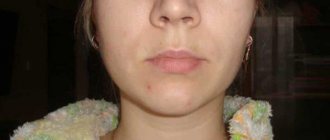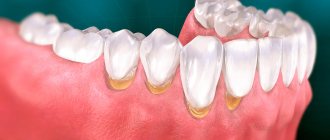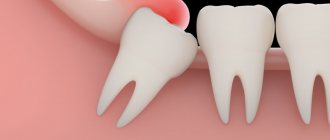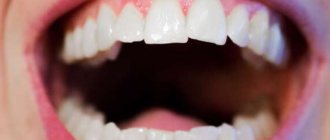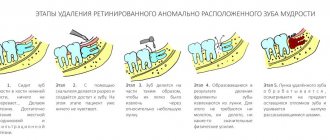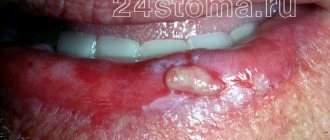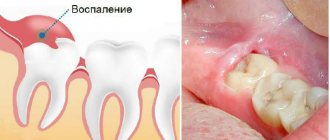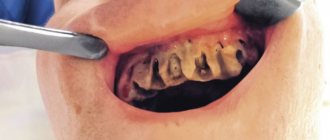Publication date: 01/11/2021
Tooth extraction is not a pleasant process. Painful sensations and swelling of the gums after extraction of a tooth are an adequate response of the body to the operation. Usually, unpleasant symptoms increase 3-4 hours after the effect of the anesthetic drug wears off. Normally, pain, swelling, redness of the mucous membrane after a conventional extraction are observed for another 2-3 days; after a complex extraction, symptoms persist for 3-5 days. If your gums hurt after tooth extraction after 7 days or longer, you need a medical examination.
Why does my gum hurt?
Unexpressed aching pain and slight swelling of the gums appear due to injuries to soft tissues, nerves, and jaw bone when removing a tooth from its bed. The gum tissue swells, the nerve endings are compressed, hence the pain. How much your gums hurt after tooth extraction depends on:
- Patient's pain sensitivity;
- degree of complexity of the intervention;
- features of the clinical case;
- location of the dental unit (after extraction of molars, the injury is greater, the pain lasts longer);
- state of immunity.
The body’s normal response from the development of complications is distinguished by the following properties: the pain does not intensify, pathological symptoms are present for no more than 7 days, and no other signs of deterioration in well-being are observed.
Correction of common complications
General violations occur less and less often in dentists’ offices. This is due to the latest technologies in this area, which allow treatment to be carried out painlessly and quickly, as well as the development of asepsis and antiseptics. But some complications still arise, although this does not happen as often as before.
If the patient’s eyes are cloudy due to fear of intervention, use a cotton swab soaked in ammonia. It is brought 7-10 cm from the nose, which brings the person to his senses. If anxiety does not go away, medical sleep is offered as pain relief.
If there is a large loss of blood during the operation, you need to carefully and promptly make up for the deficiency. Otherwise, vascular disorders develop, including hypovolemic shock and cardiac failure. Therefore, treatment should be carried out only in well-equipped clinics.
Low-grade fever is considered a normal reaction of the body to the intervention. But if it goes beyond 38.5 ºС for several days, you need to inform your doctor about this - the symptom may indicate the onset of a complication.
How long does your gum hurt after tooth extraction?
Normally, after 1-3 days, tissue swelling gradually decreases, pain goes away, and health improves. Already on the 3-4th day, the blood clot is gradually replaced by granulate, and after a week it fills the entire hole. After tooth extraction in the upper jaw, the recovery time is identical to the lower jaw, but bone regeneration in the upper dentition occurs more slowly.
In some clinical cases, the surgeon may cut the gum and drill out the jaw bone. Typically, such manipulations accompany the extraction of the outer eighth molars (wisdom teeth). Then healing takes longer than after a simple operation.
If 5-7 days after the intervention the pain does not decrease, but rather becomes more intense, you should consult a doctor. Acute, nagging, constant pain after tooth extraction can be a symptom of complications.
The tooth socket heals in approximately 2-4 weeks. Recovery time depends on the parameters of the wound and the body’s reaction to the removal procedure. Bone volume is restored approximately 6 months after the intervention.
Prevention measures
Naturally, it is necessary to consult a doctor in a timely manner and begin treatment, since the inflammatory process can lead to serious consequences. For preventive purposes, you must remember the following:
- Tooth extraction operations should only be performed by a trusted, experienced specialist who works specifically in the field of surgery;
- Follow all doctor’s recommendations for treatment and recovery exactly to avoid negative consequences;
- Undergo complex treatment without completing it in advance because you feel well. Interruption of therapy until complete recovery can cause an aggravation of health, lead to the formation of bacteria and a new inflammatory process.
With proper treatment and no complications, the problem is cured within a few days.
The patient must remain in bed for several days to fully recover. Minor pain in the area of the extracted tooth may periodically bother you for 3 weeks, but it will be less intense and will gradually go away. Remember, it is important to consult a doctor in a timely manner and undergo comprehensive treatment so as not to bring your health to a critical point. This article is for informational purposes only, please consult your doctor for details! Ask your doctor about contraindications and side effects.
What happens if you ignore pathological pain
The appearance of pain always signals a problem in the body. If the tooth was removed long ago, and the pain persists or increases, this is evidence of a complication. Pain may be associated with:
- Increased body temperature;
- severe swelling, redness of the mucous membrane;
- halitosis;
- purulent discharge from the socket;
- white or gray coating on the mucous membrane;
- enlargement of the submandibular lymph nodes;
- pain while swallowing;
- restriction when opening the mouth.
In this situation, you should see a doctor immediately.
Ignoring alarming symptoms is fraught with serious problems, such as abscess and osteomyelitis. These are serious pathologies that require timely, qualified treatment.
Limited osteomyelitis of the tooth socket
Inflammation of the bone tissue in the area of the extracted tooth :
- in the socket of the extracted tooth , and pain occurs in the adjacent teeth;
- Weakness, severe headache;
- Body temperature is 37.6-37.8°C and above, sometimes there is chills;
- Loss of sleep and performance;
- The bottom and walls of the hole are covered with a dirty gray mass with a fetid odor;
- Touching the gum is sharply painful;
- When you tap adjacent teeth, pain occurs;
- The perimandibular soft tissues are swollen, the submandibular lymph nodes are enlarged, dense, painful;
The symptoms of acute inflammation last 6-8 days, sometimes 10 days, then they decrease, the process passes into the subacute and then into the chronic stage.
- The pain becomes dull and weak;
- General condition improves;
- Body temperature normalizes;
- After 12-15 days, the tooth socket is filled with loose, sometimes protruding pathological granulation tissue, which, when pressed, releases pus.
Please note that pain relief during a complication does not mean that the process has begun to heal; perhaps it has entered a chronic, more dangerous stage. As a rule, the surgeon schedules a follow-up examination for the patient after removal; ATTENDANCE IS MANDATORY!
How to get rid of pain at home
To eliminate postoperative pain, the dentist will prescribe analgesics and cold compresses on the side of the intervention. Additionally, you can use traditional methods - mouth baths made from tinctures or herbal decoctions. Baths with an antiseptic drug are also allowed (the solution must be held in the mouth for a while and spat out). What is strictly forbidden:
- warm the operated area;
- rinse your mouth intensively (you can wash out the blood clot);
- chew on the injured side;
- “check” the hole using your tongue, fingers, and apply medicine to it.
The risk of complications depends on the complexity of the operation to remove a dental unit. Simple extraction is carried out if the tooth does not have strong, intertwined roots, it is intact, and there are no associated problems (cysts, pulpitis, periodontitis, etc.).
Extraction of dystopic teeth, which are very crooked, have intertwined, crooked roots, with a destroyed coronal part, and with an inflammatory process, is considered difficult. In such cases, a more extensive operation may be necessary with a preliminary incision in the gum, sawing the tooth into elements, extracting fragments through a hole in the jaw bone, and applying sutures. Molars are usually difficult to remove. If your gums hurt for several days after the removal of a molar, but the painful symptoms are smoothed out, then the wound is healing normally.
Treatment of alveolitis
When the socket becomes inflamed, the main thing is to eliminate the source of infection, prevent the development of inflammation and preserve the dentition. In order to alleviate the patient’s condition, the dentist uses the following therapy methods:
- Mechanical cleansing of the hole, washing out purulent residues with a solution of nitrofural or hydrogen peroxide.
- Anesthesia of the hole. The pain syndrome is relieved with the help of local applications with anesthetics and analgesics. To do this, the doctor applies the lotion for half an hour and then removes it to prevent the proliferation of microbes in the area. The dentist will advise the patient to repeat the procedure several times a day. Taking painkillers orally is not recommended.
- Taking antibiotics. In the presence of concomitant diseases, alveolitis is treated with antibiotics.
With the right approach, the signs of alveolitis subside 2-3 days after the start of treatment. If therapy was not started on time, residual pain may drag on for 2–3 weeks.
With the permission of the dentist, additional treatment of alveolitis with folk remedies is possible:
- Sage rinses. To prepare the solution, brew a large spoonful of dry sage in 250 ml of boiling water, leave the mixture for an hour, wrapping the container in a towel. After this, the liquid should be filtered and used for rinsing.
- Gargling with chamomile flowers. To prepare the composition, brew a large spoonful of chamomile flowers in a glass of water for 15 minutes, insulating the container with a towel. The infusion should be strained and rinsed your mouth up to 12 times a day.
- Poplar buds. To prepare, take half a glass of buds, pour into a glass container and pour in 500 ml of vodka. The product should be infused for 10 days in the dark and cool, then filtered, soaked in cotton swabs and applied to the inflamed area.
- A soda rinse solution can also be an effective addition in the treatment of alveolitis. You should take a large spoonful of powder in a glass of warm water or mix soda with water to obtain a paste-like mass, which then needs to be used to treat the hole.
- Burdock leaves. To prepare a medicinal decoction of burdock leaves, you need to pour 20 grams of raw material with 2 glasses of water, and then simmer the mixture over low heat for about 40 minutes. The resulting solution should be cooled and filtered, and then used for rinsing.
- Aspen bark. Pour 1 tablespoon of crushed aspen bark into one glass of boiling water. It is important to leave the solution in an airtight container for 3 hours, and then use 100 ml of strained warm liquid at least 3 times a day.
- Anise infusion. To prepare the infusion, pour 1 tablespoon of anise into 200 ml of boiling water, and then keep in a thermos for 50 minutes. The liquid should be filtered and used to rinse 3 times a day.
Root removal
How is the root of a tooth removed if the tooth is completely destroyed? Despite this situation, extraction is not always recommended. If, after diagnosis, the doctor determines that the root can be used for an inlay, then the tooth is restored with a crown. But if there is pain, an unpleasant smell and taste, or swelling has developed, then dental care is required urgently. In this case, the question of whether to remove the roots of the teeth is decided in favor of the operation, since the neglected condition can also lead to the loss of neighboring elements.
Regardless of the chosen technique, pain relief and X-ray control are required after removal. This allows you to make sure that there are no root fragments in the cavity, since it is often loose and can crumble under slight pressure from the forceps.
